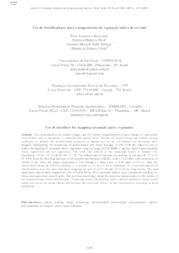Uso de classificadores para o mapeamento da vegetação nativa de cerrado.
Uso de classificadores para o mapeamento da vegetação nativa de cerrado.
Author(s): REYNALDO, E. F.; POVH, F. P.; SABOYA, L. M. F.; VILELA, M. de F.
Summary: ABSTRACT- The environment is in constant change, and for a better comprehension of these changes it is necessary observations with an amplitude of temporal and spatial scales. The use of geoprocessing and remote sensing techniques to identify the modifications promoted by human race in the environment are becoming more frequent, highlighting the monitoring of deforestation and illegal burning. In this work the objective was to realize the mapping of savannah native vegetation using an image CCD/CBERS-2 and the classification methods visual, supervised and non supervised. The work was realized in the municipal district of Gurupi, TO, coordinates 11° 44' 47" S and 49° 04' 15" W. The delimitation of the area was defined by the map SC-22-Z-DIV-4-NE from the Brazilian Institute of Geography and Statistics (IBGE), scale of 1:25.000, with a total area of 19,093.19 ha. After the image registration it was obtained a mean error of 0.48 pixel or 9.6 m. After the classification using the different methods it is possible to say that for local conditions, the visual and supervised classifications were the most indicated, mapping an area of 6,112.19 and 4,173.40 ha, respectively. The non supervised classification mapped an area of 6,646.00 ha. The exactitude indices were considered excellent for visual and supervised classification. The previous knowledge about the area was indispensable to the results of the visual and supervised classifications. A non supervised classification with a reduced number of classes could reduce the excess of similar classes and increase the exactitude indices for the classification, according to local conditions.
Publication year: 2009
Types of publication: Paper in annals and proceedings
Unit: Embrapa Cerrados
Observation
Some of Embrapa's publications are published as ePub files. To read them, use or download one of the following free software options to your computer or mobile device. Android: Google Play Books; IOS: iBooks; Windows and Linux: Calibre.
Access other publications
Access the Agricultural Research Database (BDPA) to consult Embrapa's full library collection and records.
Visit Embrapa Bookstore to purchase books and other publications sold by Embrapa.

